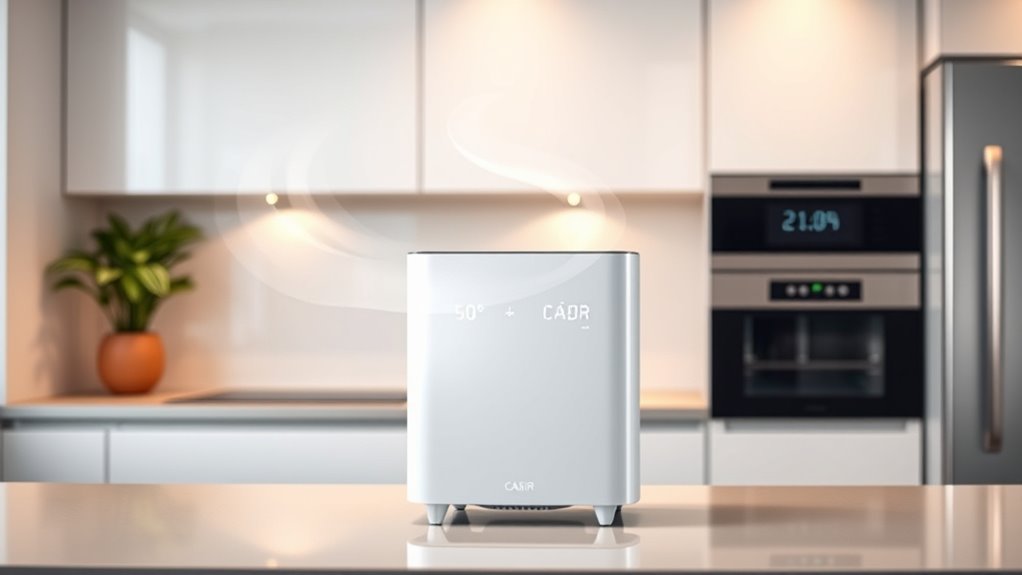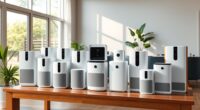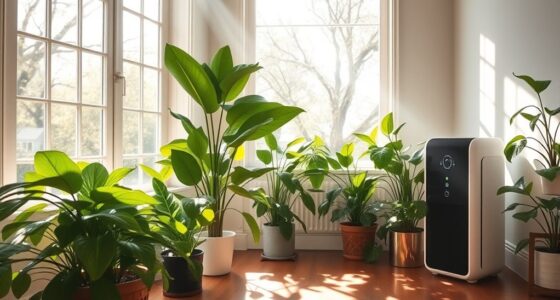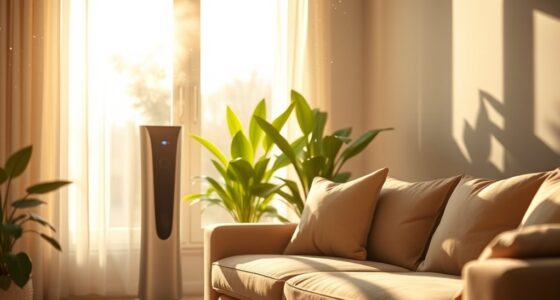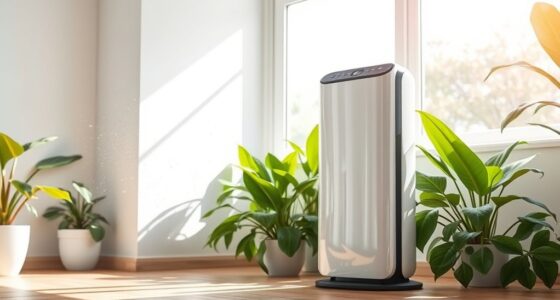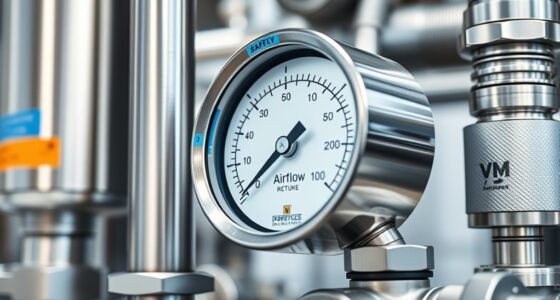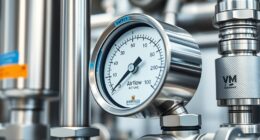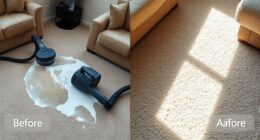Understanding CADR ratings is key to choosing an effective air purifier. CADR, or Clean Air Delivery Rate, shows how well a purifier removes smoke, dust, and pollen, measured in cubic feet per minute (CFM). A higher CADR means faster air cleaning, but remember, real-world performance can vary. Consider the noise levels and energy consumption, too, when placing your purifier. If you want to discover more about making the best choice, keep going!
Key Takeaways
- CADR (Clean Air Delivery Rate) measures air purifier efficiency in removing smoke, dust, and pollen, expressed in cubic feet per minute (CFM).
- Higher CADR ratings indicate better airflow and faster cleaning capabilities, crucial for determining air purifier effectiveness in larger rooms.
- CADR is tested under controlled conditions at maximum fan speed, which may not reflect real-world performance or lower settings.
- Noise levels and energy consumption increase with higher fan speeds, so consider comfort and cost when selecting an air purifier.
- Choose air purifiers with CADR ratings exceeding 270 CFM and HEPA filters for optimal fine particle removal and odor control.
What Is CADR?
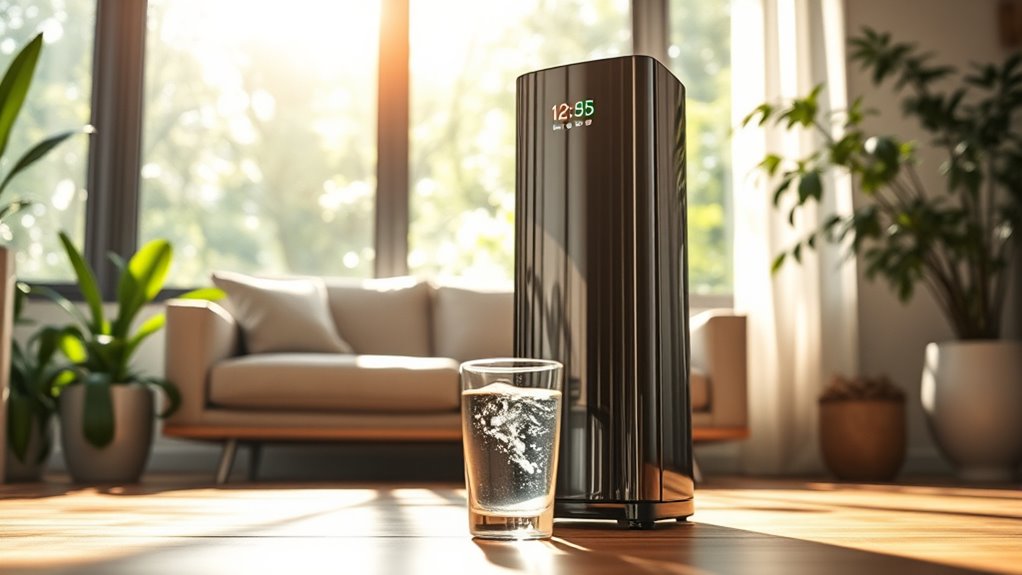
CADR measures the performance of air purifiers, specifically how efficiently they clean the air by removing smoke, dust, and pollen. Ratings are expressed in cubic feet per minute (CFM), with maximums of 400 CFM for dust and 450 CFM for smoke and pollen. These ratings come from standardized tests conducted by the Association of Home Appliance Manufacturers (AHAM), ensuring reliable comparisons between models. A higher CADR rating indicates better air flow and faster cleaning capability, making it vital for your indoor air quality, especially in larger spaces. Additionally, understanding room coverage size helps you select an air purifier that effectively meets your specific needs. Regular use of air purifiers can lead to improved respiratory health, particularly for those with allergies or asthma. Effective filtration, such as HEPA filtration, plays a key role in achieving optimal air quality. Moreover, many air purifiers utilize advanced technology to enhance their cleaning capabilities, ensuring a healthier environment. Proper air purifier maintenance is essential to maintain efficiency and prolong the life of your device.
Understanding CADR helps you avoid misleading marketing claims and choose the right air purifier efficiently.
Benefits of CADR

When choosing an air purifier, understanding the benefits of CADR ratings can greatly enhance your decision-making process. CADR ratings provide a standardized measure of air purifier performance, indicating cleaning effectiveness for smoke, dust, and pollen. A higher CADR rating means quicker air cleaning capability, especially in larger spaces. This is similar to how top models of vacuums are designed for efficient cleaning in specific environments, making it essential to consider suction power when selecting an air purifier. Additionally, advanced air purification technology can further enhance the functionality of air purifiers, allowing for remote monitoring and control.
| CADR Rating | Airflow (CFM) | Recommended Use |
|---|---|---|
| 270 CFM | Minimum | Small Rooms |
| 400 CFM | Dust | Medium Rooms |
| 450 CFM | Smoke/Pollen | Large Rooms |
These ratings also balance filter efficiency, noise levels, and energy consumption, ensuring you select an air purifier that meets your needs without compromising on performance. Additionally, understanding color palettes in design can help create a more harmonious living environment when enhancing air quality with an air purifier.
How CADR Is Tested
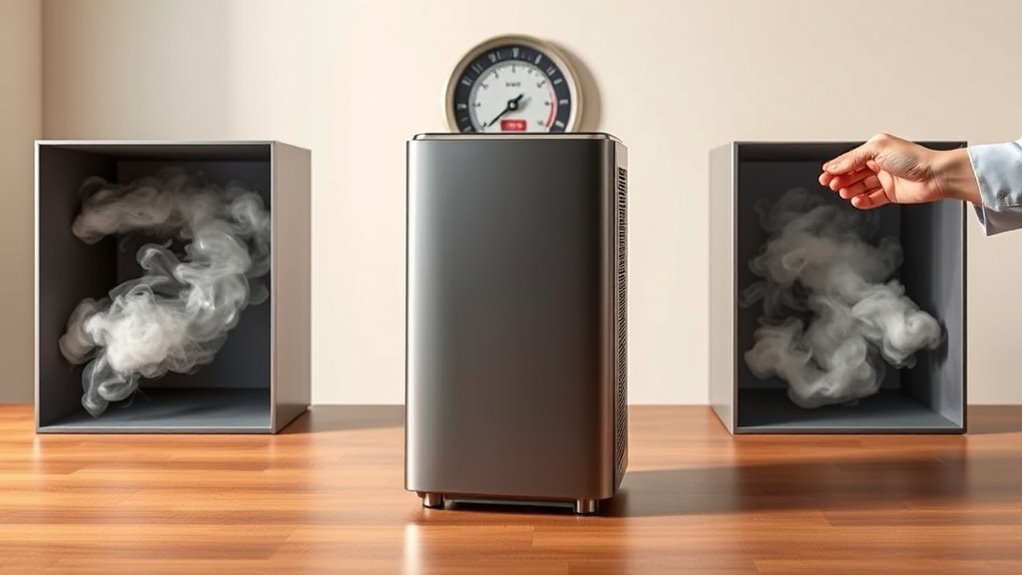
Here’s how the CADR test works:
- The air purifier is tested at its maximum fan speed, simulating ideal performance.
- Specific particle pollutants, such as smoke, dust, and pollen, are introduced into the chamber.
- The humidity is maintained at 40% and temperature at 70°F for consistency.
- Particle counting equipment measures pollutants removed by comparing levels with the unit on versus off. Regular maintenance of the unit can significantly improve its efficiency and effectiveness in maintaining a high energy efficiency rating. Additionally, effective maintenance practices can help ensure that air purifiers operate at peak performance. Consistent filter replacement is also vital to maintain optimal airflow and pollutant removal.
These strict protocols in testing facilities assure accurate measurement of the Clean Air Delivery Rate, allowing consumers to trust the CADR ratings of air purifiers. Additionally, understanding air purifier maintenance is crucial for ensuring the longevity and effectiveness of the device in delivering clean air. Furthermore, many energy efficiency programs encourage the use of energy-efficient appliances to optimize indoor air quality while reducing overall energy consumption.
How CADR Is Calculated
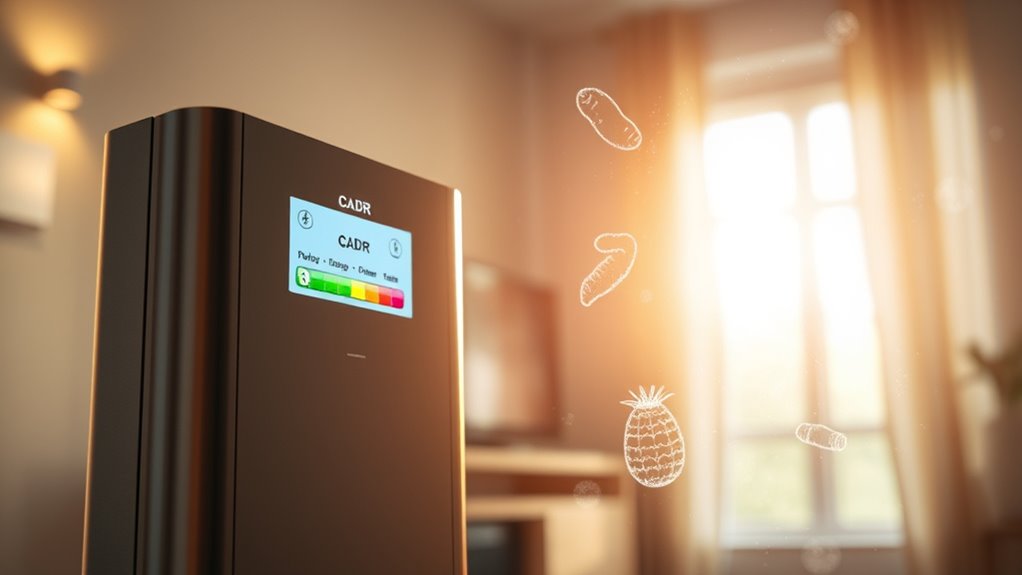
Calculating the Clean Air Delivery Rate (CADR) involves a straightforward yet precise method.
First, the difference in pollutant concentration is measured in a test chamber with the air purifier both on and off. Using the formula: (amount removed with the unit on – amount removed with the unit off) x room size, you can determine the CADR. Airless paint sprayers also utilize precise measurements to ensure optimal performance, showcasing the importance of proper technique in achieving desired results. The effective application of paint with airless sprayers can be likened to the accurate measurement of air quality, as both require consistent methodology for achieving optimal outcomes.
The Clean Air Delivery Rate (CADR) is calculated by measuring pollutant concentration differences with the air purifier on and off.
Testing occurs in controlled environments, ensuring consistent temperature and humidity, typically at 70°F and 40%. Color accuracy is also crucial for presenting a clear visual representation of the air quality data during testing. Understanding the refrigeration cycle can also be beneficial, as it highlights the importance of efficient systems in maintaining indoor air quality.
The CADR scores reflect the efficiency of filter effectiveness and airflow, with higher scores indicating faster pollutant removal. Ratings are expressed in cubic feet per minute (CFM), making it easy to compare different air purifiers based on their performance against dust, smoke, and pollen. Additionally, understanding energy-efficient models can help consumers select air purifiers that not only improve air quality but also save on electricity costs.
CADR Limitations
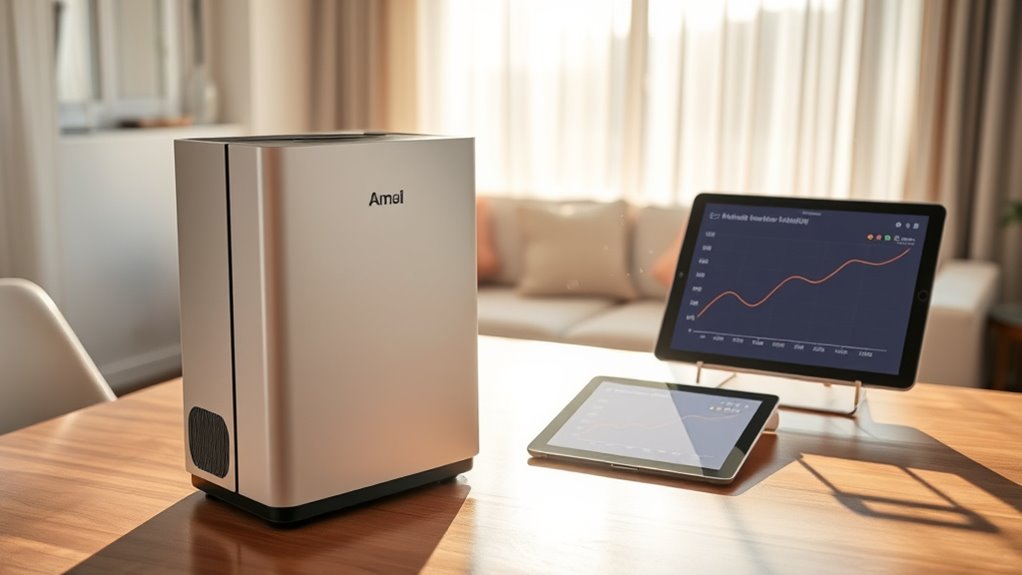
While CADR ratings can give you a good idea of an air purifier’s potential, they come with limitations you should know about. Testing environments often don’t mimic your home, and running at max speed can be noisy and use more energy than you’d like. Plus, high ratings might drop quickly if you’re not considering filter maintenance and room size. Additionally, understanding energy efficiency ratings is crucial, as they impact the overall performance and operating costs of your air purifier.
Testing Environment Constraints
Although CADR ratings provide a benchmark for air purifier performance, they can be misleading due to the controlled testing environments used to obtain them. These environments don’t always reflect real-world performance.
Here are some key constraints:
- Variations in Room Size: CADR ratings are based on specific chamber sizes, which may not match your living space.
- High Fan Speed: Testing involves running air purifiers at maximum speeds, inflating ratings that aren’t achievable at lower settings.
- Filter Effectiveness: Smaller purifiers might show high initial CADR ratings, but performance can drop as filters become less effective.
- Ozone Production and Noise Levels: CADR doesn’t consider potential safety concerns like ozone production or the noise levels, affecting consumer effectiveness.
Noise and Energy Impact
When you choose an air purifier, it’s essential to contemplate how noise and energy consumption impact your overall experience.
While CADR ratings reflect performance at high fan settings, they can lead to increased noise levels and energy consumption. This can affect user comfort and operational costs, especially if you need a quieter environment.
Adjusting fan settings throughout the day might yield a lower CADR in real-world conditions than what’s rated. Additionally, if your room is oversized or has high ceilings, the effectiveness of air purification may diminish.
Manufacturer recommendations for room sizing based on CADR should be carefully considered to avoid unnecessary energy use and costs without significant improvements in air quality.
Real-World Performance Variability
Since CADR ratings are determined under controlled conditions, they often don’t mirror real-world performance accurately. Here’s why:
- Room Size: CADR ratings are typically based on smaller spaces, so effectiveness might drop in larger rooms with poor air circulation.
- Fan Settings: Higher CADR ratings are achieved at maximum fan speeds, but you might prefer lower settings for reduced noise, which can cut purification effectiveness.
- Noise Level: Increased fan speed can lead to higher noise levels, impacting your comfort.
- Additional Factors: CADR doesn’t account for filter longevity or safety issues like ozone production, both essential for effective air quality management and energy efficiency.
Understanding these limitations helps you choose air purifiers that truly meet your needs.
Choosing the Right Air Purifier
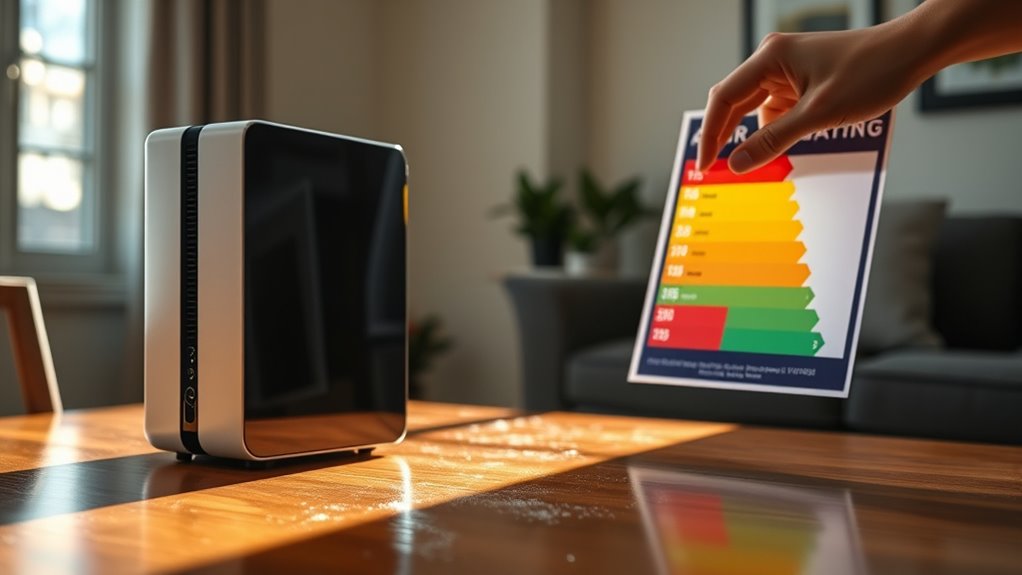
Choosing the right air purifier can greatly enhance your indoor air quality, so it’s vital to take into account key factors.
First, look for a CADR rating that meets or exceeds 270 CFM to guarantee effective air cleaning for your room size. Check the CADR ratings for smoke, dust, and pollen, as these indicate how well the purifier handles specific pollutants.
Pay attention to filter types; HEPA filters are essential for removing fine particles, while activated carbon filters tackle odors and VOCs.
Finally, consider noise levels, since higher fan speeds can increase sound, impacting your comfort.
Frequently Asked Questions
What Is a Good Cadr Score for an Air Purifier?
A good CADR score for an air purifier is ideally at least 270 CFM. This level guarantees effective air cleaning in most residential spaces.
If you want top-tier performance, look for models with CADR ratings up to 450 CFM for smoke and pollen or 400 CFM for dust.
Just remember, while higher scores indicate better filtration, always consider your room size and maintain the filters for peak performance.
Is 200 CADR Good?
A CADR of 200 is generally acceptable for small to medium-sized rooms, but it mightn’t be the best choice for everyone.
If you’re dealing with high levels of dust, pollen, or smoke, you may want to contemplate a higher rating for more effective air cleaning.
For spaces around 200-300 square feet, a CADR of 200 will work, but going for at least 270 could enhance your indoor air quality considerably.
Is 300 CADR Good?
You might wonder if a CADR rating of 300 is good. The truth is, it generally is for medium-sized rooms.
With this rating, you’re looking at effective air cleaning for spaces up to roughly 450 square feet. It efficiently tackles common pollutants like smoke, dust, and pollen.
However, if your space is larger or you face worse pollution, a higher CADR could enhance your air quality even more. Always consider your specific needs!
What Is a Good Air Quality Number for Air Purifier?
When choosing an air purifier, you should look for a good air quality number, typically indicated by the Clean Air Delivery Rate (CADR).
Aim for a CADR score above 270 CFM for effective cleaning in most rooms. Higher numbers, like 400 CFM for dust or smoke, show better performance.
The right rating guarantees your purifier efficiently removes allergens and pollutants, improving your indoor air quality considerably.
Don’t settle for less when it comes to your health!
Conclusion
In the world of air purifiers, understanding CADR ratings is essential for making an informed choice. With the right knowledge, you can sift through the noise and find an air purifier that suits your needs. Remember, not all purifiers are created equal, and CADR helps you separate the wheat from the chaff. So, when you’re ready to breathe easier, let CADR guide you to cleaner, fresher air in your home.
